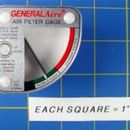Is it time to replace the filter?
I asked this at More Energy Myths a few weeks ago but haven’t seen a response so I will post it here.
Four and five inch media filters are pricey and there is a device by General Aire (http://www.generalfilters.com/search/G99-Air-Filter-Gage_PT60.html ) to help you determine when it’s time to replace the filter. It’s mounted between the filter and the blower. You zero in the gauge at the time you install a new filter and then the indicator gradually swings towards the “replace” zone as the filter loads and vacuum increases. Although this might be helpful, it seems to me if you used an actual vacuum gauge, say the 0-30 IN-Hg you have laying around from your shade tree mechanic days, you could make a more accurate evaluation. But what Hg reading should you be looking for?
GBA Detail Library
A collection of one thousand construction details organized by climate and house part










Replies
According to this page: http://www.texairfilters.com/news/testsonpressuredrop.htm, most typical filters are in the range of .1-.3 inches of water column pressure drop, with the higher MERV ratings being upwards of .4-.5 inches - inches of water being the most typical pressure scale used in HVAC, not inHg. These pressure ranges are too small for a mercury scale based gauge - 1 inch of water is less than a tenth of an inch of mercury (mercury is 13.5 times as dense as water). But there are a bunch of differential pressure gauges that should work for you - this Dwyer, for example: http://www.amazon.com/Dwyer%C2%AE-Magnehelic%C2%AE-Differential-Pressure-Range/dp/B00C1RA4RY/ref=sr_1_6?ie=UTF8&qid=1373813476&sr=8-6&keywords=dwyer+differential+pressure+gauge
It also depends on your system. Many ducted minisplits, for example, can handle only up to 0.2 inches for the entire system - ductwork, fittings, grilles, and filter. Furnaces deal with system pressures around 0.5" and up.
So I'd say get a gauge on there see what pressures it starts out at, then check it once in a while and see how the pressure increases as it gets dirtier. Just a wild guess here, but a pressure more than 50% higher than when you started means it should be cleaned or replaced.
Thank you for the information and links. Cramer. I live in N. Florida and have a three year old Heil two ton heat pump with two-speed blower inside, which is connected to seven registers via a lot of flex duct in the attic. (Reading Green Building Advisor, I know the duct work should be inside the building envelope.) The filter size is 16x20x4 inches. I don't know how much air is being moved when the blower is operating at full speed. Maybe I will try making a water column to experiment with rather than purchase a gauge.
Bob,
Happy to help! There's also this gauge which is a bit cheaper: http://www.amazon.com/Manometer-Accuracy-Stationary-Portable-Applications/dp/B00C1RABCM/ref=sr_1_1?ie=UTF8&qid=1373826104&sr=8-1&keywords=dwyer+mark+ii+gauge